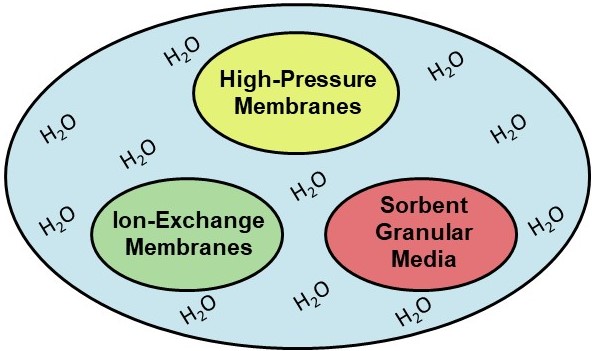Coronell Research Group
Water and Energy
Research
Overview
We study membrane-based processes for water purification and energy production and storage, and sorption processes for the removal of contaminants from water. We study technologies with applications in municipal, industrial, and household systems. Research in our laboratories currently focuses on: (i) high-pressure membranes for water purification, (ii) ion exchange membranes and their applications, and (iii) sorbents for water treatment. A brief description of our research focus areas is provided below. You can visit “NC Pure” to learn about our current collaborative work with the Leibfarth Laboratory (Chemistry) for the development and evaluation at pilot scale of a novel sorbent for PFAS removal from water. For additional specific outputs of our group, please visit the Publications and Presentations sections.
High-Pressure Membranes for Water Purification
The increasing scarcity of fresh drinking water sources around the world and the increasingly stringent regulations for drinking water production have made membrane technologies attractive options for water purification as they are able to remove a broad range of contaminants in one step. The capacity of high-pressure membranes to remove a broad range of contaminants from water, including salts and small organics, allows for the use of membrane technology to treat conventional water sources (i.e., river, lake, and well water) as well as unconventional water sources (e.g., seawater, reclaimed effluent). In particular, high-pressure membranes have become key technologies in seawater desalination and water reuse systems, both of which have become a necessity, rather than just an attractive option, in various parts of the world. Our group has pioneered experimental methods for the quantitative characterization of physico-chemical properties of the ultrathin selective barriers of thin-film composite and nanocomposite membranes and water-membrane and contaminant-membrane interactions. We continue to develop characterization methods and use these methods to study practical problems such as membrane aging and fouling, as well as basic problems such as the relationship between membrane physico-chemical properties and performance. We also use the characterization methods to facilitate the development of improved membranes.
Example high-pressure membrane projects our group has worked on are:
- Development of antibiofouling thin-film composite (TFC) membranes (JMS 2018, 556, 85-97; JMS 2019, 579, 151-161)
- Development of methods for the characterization of the void structure and charge density of the polyamide active layers of TFC and TFN membranes (JMS 2016, 497, 365-376; JMS 2013, 429, 23-33)
- Modelling salt and weak acid transport through TFC membranes (ES&T 2013, 47, 420-428),
- Characterization and modeling of the kinetics of chlorine uptake and amide link scission in the polyamide active layer of TFC membranes upon exposure to free chlorine (ES&T 2014, 48, 2741-2749; ES&T 2015, 49, 12136–12144)
- Fouling of nanofiltration membranes treating groundwater containing silica (JMS 2014, 468, 349-359; JMS 2017, 522, 31-44)
- Development of a reverse osmosis-ion selective electrode system to monitor chloride in turbine steam condensate (SST 2017, 52, 2473-2486)
Ion Exchange Membranes and Their Applications
Ion-exchange membranes (IEMs) are essential components of processes used for a variety of applications, including water desalination, generation and storage of energy, resource recovery, generation and purification of valuable chemicals, and more. The efficiency, economics, and even feasibility of these processes is highly dependent on the physical, chemical, and transport properties of the IEMs. We study fundamental and applied aspects of ion exchange membranes, with a focus on ion and water transport phenomena through them, and energy-related applications such as reverse electrodialysis (RED). In RED, waters with different salt concentrations (such as sea and river water) mix together to generate energy. This process can be understood as the reverse of desalination, which consumes energy. “Blue energy” technologies like RED could someday provide a reliable, consistent source of zero-emission renewable energy, in addition to serving a range of other applications including energy recovery from industrial processes and energy storage.
Example ion-exchange membrane projects our group has worked on are:
- Evaluation of reverse electrodialysis for sustainable power generation using natural waters (JMS 2017, 541, 621-632; JMS 2018, 554, 39-47)
- Development of salinity-gradient based energy storage (JMS 2015, 495, 502-516; ES&T 2017, 51, 1910-1917)
- Transport phenomena in ion exchange membranes (ACS AMI 2018, 10, 39745-39756; I&ECR 2019, 58, 18663-18674)
- Improving measurements of permselectivity for ion exchange membranes (ES&T 2018, 52, 4929-4936)
Sorbents for Water Treatment
While membrane technology can be used for the removal of any type of contaminant from water, this cannot always be done in an economically feasible manner. Membrane technology is typically used only when other more conventional technologies are not able to achieve the desired results. One such technology is sorbent granular media, which is a well-established technology for applications at the municipal scale and home scale (i.e., point-of-use, POU, point-of-entry, POE, scale). We are particularly interested in the use of sorbents for removal of organic matter (e.g., NOM to reduce membrane fouling), metals (e.g., arsenic, lead), and per- and polyfluoroalkyl substances (PFAS) from water.
As part of our sorbent work, we work collaboratively with the Leibfarth Laboratory (Department of Chemistry) on the development and and evaluation of a novel sorbent for the removal of PFAS from water. We are currently aiming to evaluate this novel sorbent, termed Ionic Fluorogel, at pilot scale at three sites in North Carolina. We refer to this project as “NC Pure“.
Specific sorbent projects we currently work on are:
- Removal of PFAS from water using a hydrolytically stable ionic fluorogel (Angew. Chem. Int. Ed. 2022, 61, e202208150)
- Removal of PFAS from water using ionic fluorogels (ACS Cent. Sci. 2020, 6, 487-492)
- Removal of organic matter using a magnetic ion exchange resin (WR 2016, 98, 225-234; WR 2020, 172, 115460)


University Operator: (919) 962-2211 | © 2024 The University of North Carolina at Chapel Hill |